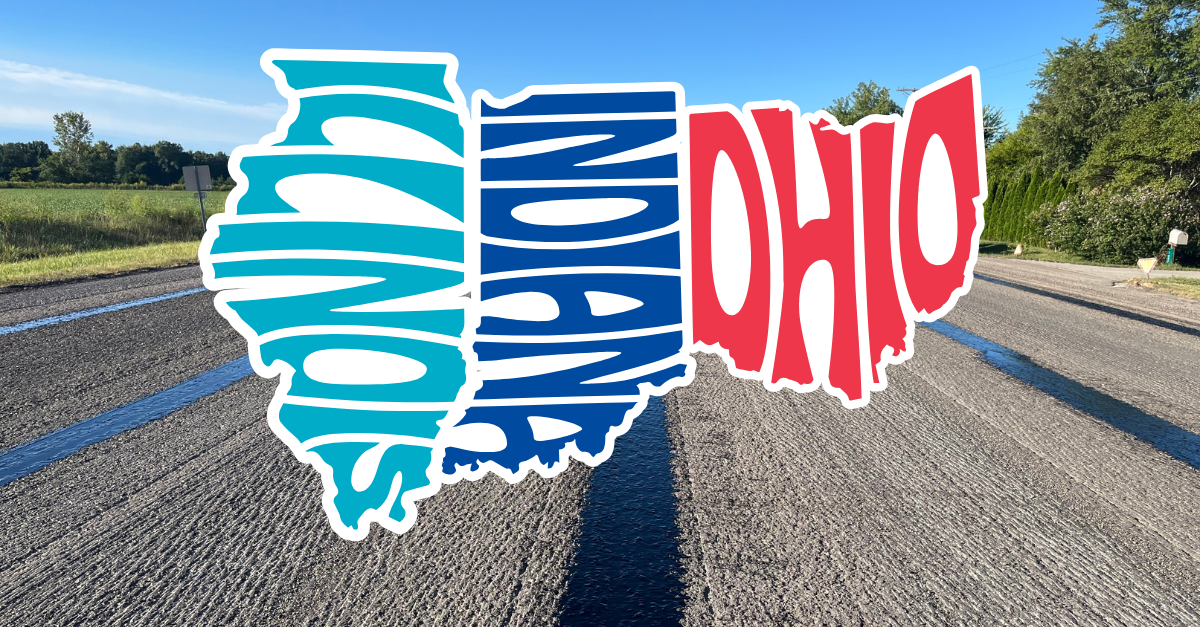Reinforcing Roads Across Indiana, Illinois, and Ohio with VRAM
Void Reducing Asphalt Membrane (VRAM)—known by the brand name, J-Band®—is transforming the way state agencies build and maintain roads. This innovative solution strengthens the most vulnerable part of asphalt pavements: the longitudinal joint. Applied before the hot mix lift, under the joint, it reinforces that joint from the bottom up. VRAM significantly extends pavement life, reducing costly maintenance and improving safety for years to come.
Over the past few months, the Departments of Transportation in Illinois, Indiana, and Ohio have incorporated VRAM into multiple resurfacing projects on major state routes. Let’s take a closer look at one project from each state.
Illinois Route 133
- Location: IL-133 in Edgar County (from the Coles County Line to IL-16 in Paris)
- Project Scope: 14.3 miles of VRAM applied over a Cold In-place Recycling (CIR) intermediate course. Details of the CIR rehabilitation can be found here.
- Contractors: Evergreen Roadworks (VRAM and CIR), Howell Paving, Inc. (Prime)
- Date: July 2025
Why VRAM? Illinois DOT was instrumental in developing VRAM as a solution for premature joint failure and was the first state to adopt it. This early project on US-51 provides over 20 years of proof that VRAM can extend the life of the joint area. Today, IDOT specifies VRAM (referred to as Longitudinal Joint Sealant – LJS) for all lane-to-lane joints in full-depth HMA pavements and overlays, citing a 3–5x ROI.
Impact: Saving Time
- Faster construction: VRAM integrates seamlessly into standard paving operations.
- Longer life: Research shows VRAM extends joint life by 3–5 years by keeping water and air out.
- Reduced maintenance: Fewer future repairs mean less downtime and fewer traffic disruptions.
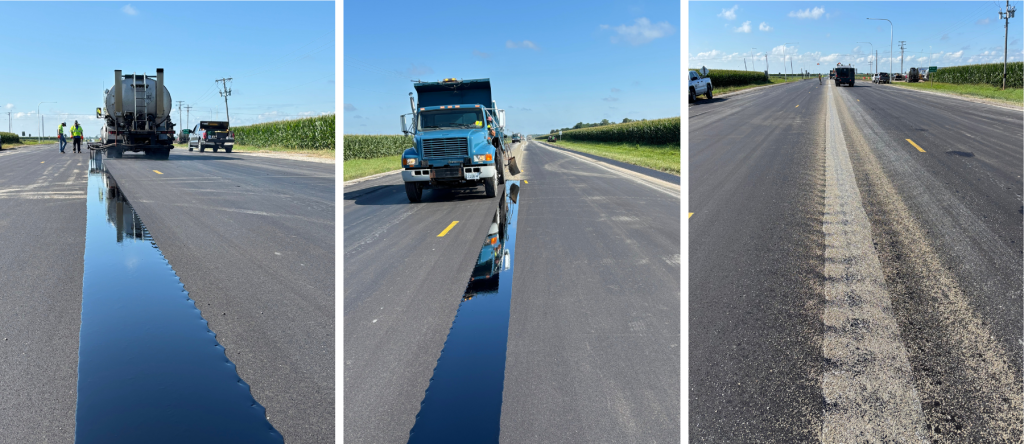
For this road, after application, the VRAM band was optionally sanded to prevent pickup before the surface course was placed—without affecting VRAM’s upward migration into the asphalt mat.
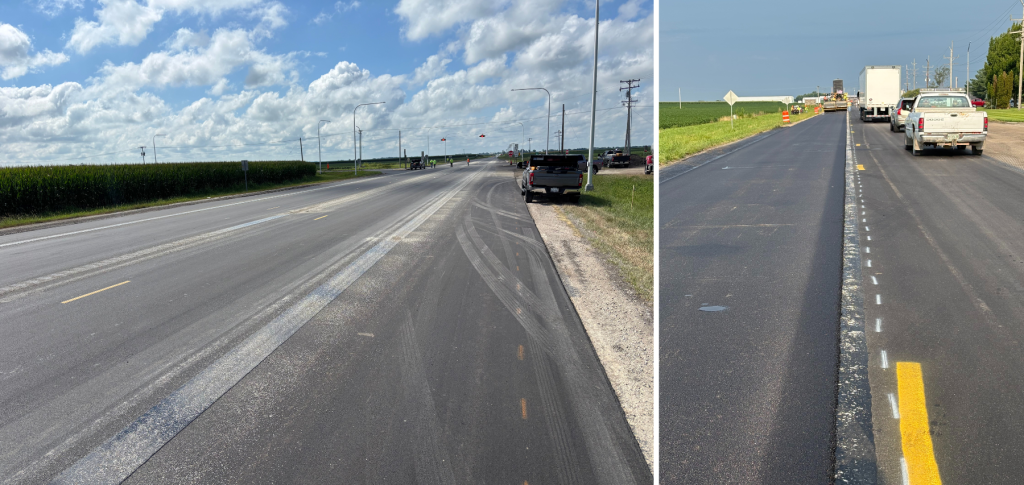
Three sanded bands of VRAM for each lane-to-lane joint. The shadow of the VRAM material on the asphalt mat demonstrates VRAM filling air voids and protecting the area around the joint. Read more about the shadow here.
Indiana State Route 37/13
- Location: SR-37/13 through Hamilton, Tipton and Madison counties (from SR-28 in Elwood south to Noblesville
- Project Scope: 14 miles of mill & fill with VRAM under multiple lane-to-lane joints (up to 5 joints wide) The intermediate course is a Cold In-place Recycling layer that was milled in preparation for the surface course.
- Contractor: E&B Paving
- Date: September 2025
Why VRAM? INDOT has used VRAM since 2016 to strengthen longitudinal joints. In 2025, the Standards Committee made VRAM a standard specification for all 401 QC/QA HMA and 410 QC/QA SMA surface courses over 300 tons.
Impact: Saving Money
- This decision is backed by data: VRAM saves agencies at least $2 for every $1 spent by reducing maintenance needs and extending pavement life.
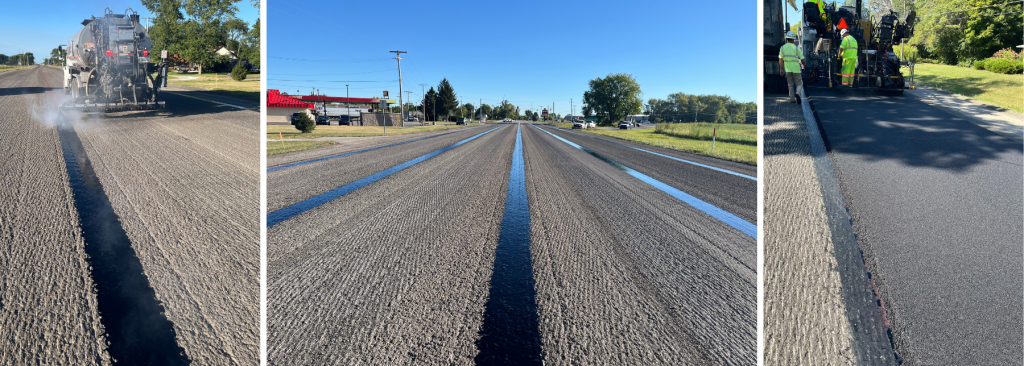
Five bands of VRAM placed below each longitudinal joint.
Ohio State Route 53
- Location: SR-53 in Sandusky County (from US-6/20 heading north to Schwartz Road)
- Project Scope: 2.4 miles of a 4-lane divided highway
- Contractors: Specialized Construction, Inc. (VRAM), Kokosing (Prime)
- Date: September 2025
Why VRAM? ODOT began testing VRAM in 2016, using control sections for side-by-side comparisons. The results—such as those on SR-168—proved VRAM’s value, leading to adoption on 250+ projects statewide.
Impact: Saving Lives
- Safer roads: Fewer maintenance interventions mean fewer work zones and less risk for crews and drivers.
- Better performance: VRAM creates a dense, durable joint by migrating upward during compaction, sealing voids from the bottom up.
- No need for density testing at the joint: The specification for VRAM allows contractors to waive density testing at the joint, eliminating the risk of having quality control technicians take centerline cores or perform nuclear density testing near live traffic.
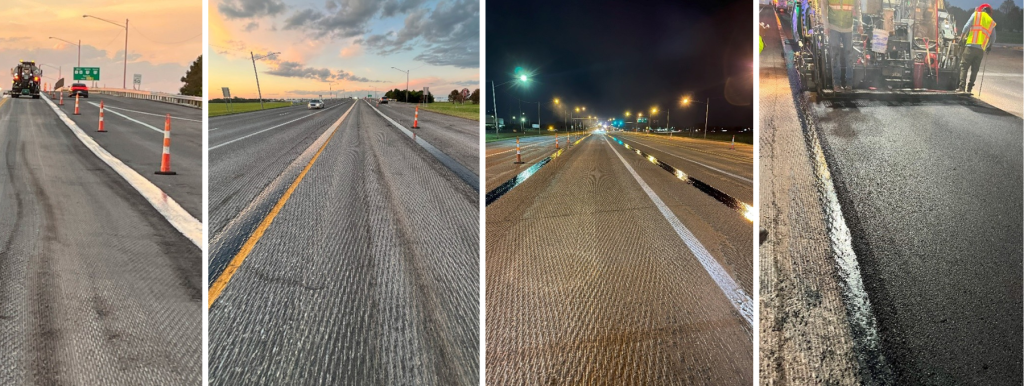
VRAM is applied before the HMA surface course paving. As the rolling operation works across the mat, the VRAM material migrates up into the air void in the pavement above it, effectively creating a dense and durable joint area.
The Bigger Picture
Across the U.S., thousands of miles of longitudinal joints are now reinforced with VRAM. Why the rapid adoption? Because it works. Joints are the weak link in asphalt pavements, often failing within seven years. VRAM acts like an insurance policy. At a small incremental cost, it delivers 3–5x ROI by preventing premature failure and keeping roads serviceable longer.
Want proof? Explore real-world results here: Project Reviews
Questions? Our team is ready to help: jbandinfo@thgrp.com
J-Band® is the premier VRAM and a registered trademark of Asphalt Materials, Inc. (AMI). J-Band was created in the labs of the Heritage Research Group (HRG) and is a product of AMI.

